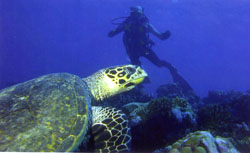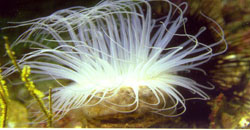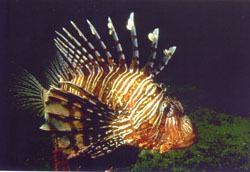Marine Life of the UAE
In our continuing series on Arabian Wildlife, Zac Sharpe takes a look at the marine life found in the UAE and Arabian Gulf
 When people think of the natural environment of the United Arab Emirates, first impressions will be of animals specially adapted to cope with barren deserts and a lack of water. Others may visualise hardy goats and elusive cats resident in the rugged mountain ranges of the east coast.
When people think of the natural environment of the United Arab Emirates, first impressions will be of animals specially adapted to cope with barren deserts and a lack of water. Others may visualise hardy goats and elusive cats resident in the rugged mountain ranges of the east coast.
But offshore, the emirate's waters are home to an enormity of wildlife species which dwarfs that of the hostile mainland environment. Green turtles, humpback dolphins, sea snakes and dugongs are all found in the waters of the southern Gulf and the east coast's Oman Gulf which laps at Fujairah's rocky shore.
For divers, the Musandam region which juts into the Straits of Hormuz provides some of the best diving imaginable. From the sea's gentle giant, the whale shark, to the less glamorous but still captivating and colourful sea anemones which blindly follow the ocean's current, the Gulf's waters are a rare treasure.
Despite the rich bounty of marine life in the local waters, only a relatively small number of people living in the cities along the coast of the UAE actually have the opportunity to witness the diverse sea life in its natural habitat. For most, their knowledge of the Gulf's marine life is
restricted to the size of the tasty hammour steak from the fish souq.
Unfortunately, out of sight has also tended to mean out of mind. Persistent oil slicks, over fishing and careless dumping of litter and waste by individuals and commercial interests, many of whom actually rely on the ocean for their livelihoods, have stretched the delicate coral and marine ecosystems to their limit.
As divers and environmentalists have brought the peril confronting the sea life of the Gulf and east coast to the fore, the government has gradually come to realise the significance of protecting the marine environment and taken the problem seriously.
Probably the best typification of the problems confronting sea life in the Gulf are the sharks. Around the world, the shark has come to represent the embodiment of man's fear of the ocean. Despite its beauty and evolution into one of the most streamlined and perfectly adapted species of the entire animal kingdom, the shark is being hunted into oblivion.
 Man needs to reconcile his fear of the shark with reality. More people are killed each year around the world by bee stings than by shark bites. While we see ourselves as the victim we lose any sympathy for the vast numbers of sharks killed each year.
Man needs to reconcile his fear of the shark with reality. More people are killed each year around the world by bee stings than by shark bites. While we see ourselves as the victim we lose any sympathy for the vast numbers of sharks killed each year.
Tonnes of shark fin fill warehouses from Fujairah to Sharjah every year for shipment to the Far East. One dealer alone in Sharjah deals in ten tonnes of shark fin every year, with most of it fished from the waters of the UAE, Oman, Yemen, Bahrain, Iran and Saudi Arabia. With 100 million sharks caught worldwide each year, it is the shark which could justifiably fear for its life from man.
Astounding, for a product with very little taste and no proven medicinal or aphrodisiac qualities, a bowl of shark soup can sell for as much as US $ 100. For this reason the sight of rows of fins hanging out to dry will continue to be a regular sight around UAE harbours.
Last year the Federal Environment Agency (FEA) called for curbs on shark fishing, acknowledging that it had detrimental effects on marine life in the region. As large predators they serve an invaluable role in keeping the balance of nature in check. As large sharks are culled, smaller species thrive. These smaller species, normally the prey of their bigger counterparts, than feed on the fish stocks which fishermen are reliant upon for their livelihood.
Sharks found locally, such the Nurse Shark, Gray Reef Shark, Blacktip Reef Shark, Whale Shark and the Great White Shark are of more value alive than dead. Divers with travel budgets to dispense with traverse the globe looking for dive sites where they can dive with sharks.
Schooling hammerhead sharks are believed to congregate in the Straits of Hormuz. The massive schools are formed by females waiting for males. The strongest and most productive females are always in the centre of such schools and the males must swim through the phalanx of lesser females to reach them. As fearsome as such a pack may look, it is possible for divers to approach and even swim with the herd.
The most awesome sight in the ocean is quite possibly that of the largest fish in the sea, the whale shark. The Gulf appears to serve as a nursery ground for these plankton-eating leviathan as almost every sighting of whale sharks in the Arabian Gulf has been of a juvenile. In Australia's north-west, one famous area for whale sharks - Ningaloo Reef - whale shark sightings are almost exclusively of fully developed adults. Whether the Gulf is a pupping site for these giant plankton feeding surface dwellers is still not fully understood.
The nurse shark is a docile animal often found asleep in the caves around the Lima Rock and other popular dive sites along the Musandam Peninsula. Tiger Sharks on the other hand are possibly the most deserving of respect. Common in tropical waters, the adult tiger can reach up to 5.6 metres in length. Although there have been no recorded incidences of attacks on divers or swimmers in the Arabian Gulf the Tiger Shark ranks above the Hammerheads, Makos, Thresher sharks and Bull sharks as potential threats. The Tiger Shark's jaws are so powerful they can bite through the shells of large turtles. As well as turtles, other sharks, scavenged livestock and humans, tiger Sharks also dine out on such attractive delicacies as sea snakes, venomous jellyfish and stingrays.
Despite being subject to the same threats, namely fishermen, as their relatives the shark, a variety of rays are found in the Gulf's waters. Amongst the most graceful is the eagle ray. Like the sting ray it has a nasty barbed sting near the base of its tail. But instead of lurking dangerously on the sandy sea bed, the eagle ray 'flies' gracefully along in open water. Eagle rays feed mostly on clams and oysters so divers looking for an elusive glimpse of the graceful creature have their best chances of spying one around wrecks and reefs laden with the ray's favourite foods.
Unlike their bottom dwelling cousins which appear to be a giant pair of wings, the eagle ray has a definite head with eyes on either side allowing for better vision. Stingrays are extremely common in Gulf Waters and the coral reefs of the east coast. Often seen during night dives, a more astute eye is often required by day as they conceal themselves in the sand before venturing out to feed in the evening.
The sea beds around Abu Dhabi are one of the few nursing grounds in the world of one of the most enigmatic of all sea creatures. The dugong, or sea cow, is a herbivorous mammal which breathes through a set of lungs and is reared on its mother's milk. It also has the dubious honour of being held responsible for the myth of the mermaid as sailors that had obviously spent too long at sea reported spying a half human, half fish-like creature.
Threatened by the eradication of rare sea grass beds from the encroachment of industry, shipping and the subsequent pollution which invariably follows, the dugong seemingly hosts a convention of relatives every February in the area. For reasons, still not understood, hundreds of animals congregate at this time of the year, swimming in intimate packs much larger than their usual herd of a dozen or so related dugongs.
Another mammal that is fairly widely distributed throughout the Gulf and the east coast is the dolphin. Strangely, it is very rarely seen around the Musandam Peninsula but is common in the gulf itself and on the coast at the other side of the Peninsula beyond the Musandam and towards the open waters of the Gulf of Oman.
Common, spinner, bottlenose and Indo-Pacific humpback dolphins are the four most commonly seen dolphins in this region. The common dolphin occurs throughout the length of the UAE and Oman coastlines. Generally they seem to occur in small groups of about 10 to 20 individuals close to the shore, although the fortunate spectator can sometimes find offshore groups of more than 100. Mixed groups of spinner and common dolphins can sometimes exceed 500 when following schools of tuna.
The graceful and playful dolphins are seemingly divided into distinct populations. Neither spinner nor bottlenose dolphins have been found in the Musandam region but are common along the east coast. They often tend to mill around close to shore and islands.
 Although commonly seen off many parts of the oman coast, it is significant that no sightings have been made of Indo-Pacific humpback dolphins or remains or beached specimens recorded. And of all the species in the Oman Natural History Museum, not one was found in the southern part of the Gulf of Oman suggesting there is some mysterious cut-off point at the Ra's al Hadd headland south of Muscat.
Although commonly seen off many parts of the oman coast, it is significant that no sightings have been made of Indo-Pacific humpback dolphins or remains or beached specimens recorded. And of all the species in the Oman Natural History Museum, not one was found in the southern part of the Gulf of Oman suggesting there is some mysterious cut-off point at the Ra's al Hadd headland south of Muscat.
Common in the arabian Gulf along the UAE and Bahrain coastlines, it would seem there are two distinct populations separated by the Gulf of Oman; one in the Arabian Gulf which spreads into the northern extreme of the Gulf of Oman and the other much further south, in the Arabian Sea.
Of the whales, the humpback is the most likely to be seen from land. It is widely distributed along the Oman and UAE coastlines on the east coast. They follow the shoals of sardines along the coast during the late winter season, but their numbers have been less in recent years. It is also highly likely that they breed in the Omani waters.
One of the more peculiarly named of the cretaceans is the false killer whale. Actually a large dolphin, the false killer whale grows to about six metres in length. With a seemingly permanent smile fixed to the blunt and slightly bulbous head, these dolphins are appropriately dubbed one of the most gregarious and inquisitive dolphins to dive with or observe from a boat.
The Gulf's fragile eco-system is the subject of the Eco-Arabia '99 conferenceon marine protection. Heightened awareness of the plight of the region's delicate coral reefs and waterways have generated protection from the government but industry leaders argue that enforcement of these regulations is the key to protecting the environment.
Illegal practices such as dumping of toxic bilge and raw sewage at sea are are a harmful but widespread practice in Middle East ports and sea lanes, despite the stringent international regulations outlawing them. Eco-Arabia '99 is looming as a watershed moment in the battle to protect the Middle East's marine and coastal environment. Accordin to Michael Julian of the International Marine organisation (IMO) laws are adequate but the enforcement of them is lax.
"There is a general consensus of opinion in the international maritime world that sufficient rules already exist and that greater emphasis should be placed on their effective implementation," he said. As well as over-fishing, oil pollution, reclamation and the spread of desalination plants were also posing huge threats to local waters, according to Dr Adel Khalifa, the regional representative of the United Nations Development Programme.
"There were 471 desalination plants in the GCC countries in 1996 producing more than nine million cubic metres of water and withdrawing about 45 million cubic metres of sea water every day," Dr Khalifa said. "The use of heavy metals in paints, especially in marine craft, is another threat that has not received due attention. Illegal discharges by both tankers and cargo vessels are endemic along the east coast," he added.
In Oman, a royal decree protects one of the most pristine coral reefs in the Middle East, the Daymaniat Islands. A long row of islands and small exposed pinnacles, they are now a valuable tourist attraction and an example of how proper enforcement of stringent rules can be economically and environmentally compatible.